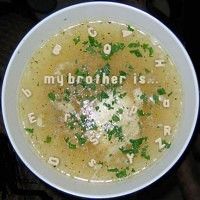Alphabet soup was always a great favourite in my home when I was a boy. Apparently, my mother thought that having the letters of the alphabet smothered in tomato sauce and sat in front of me at the dinner table would enhance my learning ability. Well, she was right. I learned very early on how to flick the letter T from the tip of my fork onto my brother’s plate. And he, in return, learned far more words with the letter F in them than my parents thought healthy, so at some stage we switched to Heinz spaghetti, which made a cute hairstyle for my sister. After that, it was sausage and mash or fish fingers.
In any case, alphabet soup played a role in many of our childhoods, and why not? It’s such a charming idea. Take boring old standard pasta and jazz it up for kids by forming it into letters. But for such a popular dinner table item, the history of alphabet soup is surprisingly mysterious. We all know about the big brand version, the colourful tins produced by Heinz or Campbell’s, but the inventor of this delicacy of the dictionary remains anonymous. Perhaps it was the child of a technician at Heinz who wanted something more from dinnertime. Or an enthusiastic educator who demanded from his local food producers a little bit of learning with every spoonful.
Some people trace the origins of alphabet pasta all the way back to Jewish communities in Eastern Europe. In the kheyder (or primary schools) of such communities children would learn their alphabet. Part of the process was the ingestion of letters made from dough which, the theory went, would aid in the memorisation of the alphabet.
What we do know, is that the term alphabet soup has passed into popular usage by the 1930s. When American president Franklin D. Roosevelt forged his “New Deal” policies to beat the Great Depression, the bewildering mixture of agencies and departments that he created was christened his “alphabet soup”. Suddenly, Washington was full of people heading to the RWA when they meant to be at the TVA, and in the confusion, they reached for the comfort of a beloved childhood dish.
By the time of the Second World War, alphabet soup was an everyday item. It was so popular that the magazine Popular Mechanics suggested using “alphabet noodles” as a way of making place cards for dinner parties as a way to beat wartime scarcity. So started a craze for making name tags from pasta shapes, which lasted well into the 1950s. Alphabet soup became both a popular dish, an educational tool and a handy identification device. Not bad for a few pieces of pasta dough.
By the time I was growing up, everyone could buy alphabet soup made by a major brand, although as far as I know none of my peers ever learned their alphabet by eating canned food. But it might have helped. The trouble was, while we could enjoy alphabet soup, there were plenty of other delicious varieties, from space invaders to halloween ghouls. With so much competition, learning your ABCs at the dinner table tended to lose out to sci-fi fantasies.
Nowadays, I still reach for a can of alphabetti-spaghetti in tomato sauce when I need a soothing burst of nostalgia. You never really grow out of forming words with the pasta before gobbling them down. A couple I know like to play Scrabble using only alphabet shapes, which can get quite messy. Others give each other mind-bending anagrams and can only eat their portion when they get the right word. That’s the beauty of eating words. For people like us who love word games, alphabet soup is a magical thing. It’s more than just a canned food. Like the pupils in Jewish schools, when we eat the words, maybe we like to think we are learning a little bit more at the same time.

